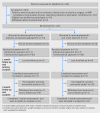Epidural steroid injections compared with gabapentin for lumbosacral radicular pain: multicenter randomized double blind comparative efficacy study
- PMID: 25883095
- PMCID: PMC4410617
- DOI: 10.1136/bmj.h1748
Epidural steroid injections compared with gabapentin for lumbosacral radicular pain: multicenter randomized double blind comparative efficacy study
Abstract
Objective: To evaluate whether an epidural steroid injection or gabapentin is a better treatment for lumbosacral radiculopathy.
Design: A multicenter randomized study conducted between 2011 and 2014. Computer generated randomization was stratified by site. Patients and evaluating physicians were blinded to treatment outcomes.
Settings: Eight military, Veterans Administration, and civilian hospitals.
Participants: 145 people with lumbosacral radicular pain secondary to herniated disc or spinal stenosis for less than four years in duration and in whom leg pain is as severe or more severe than back pain.
Interventions: Participants received either epidural steroid injection plus placebo pills or sham injection plus gabapentin.
Main outcome measures: Average leg pain one and three months after the injection on a 0-10 numerical rating scale. A positive outcome was defined as a ≥ 2 point decrease in leg pain coupled with a positive global perceived effect. All patients had one month follow-up visits; patients whose condition improved remained blinded for their three month visit.
Results: There were no significant differences for the primary outcome measure at one month (mean pain score 3.3 (SD 2.6) and mean change from baseline -2.2 (SD 2.4) in epidural steroid injection group versus 3.7 (SD 2.6) and -1.7 (SD 2.6) in gabapentin group; adjusted difference 0.4, 95% confidence interval -0.3 to 1.2; P=0.25) and three months (mean pain score 3.4 (SD 2.7) and mean change from baseline -2.0 (SD 2.6) versus 3.7 (SD 2.8) and -1.6 (SD 2.7), respectively; adjusted difference 0.3, -0.5 to 1.2; P=0.43). Among secondary outcomes, one month after treatment those who received epidural steroid injection had greater reductions in worst leg pain (-3.0, SD 2.8) than those treated with gabapentin (-2.0, SD 2.9; P=0.04) and were more likely to experience a positive successful outcome (66% v 46%; number needed to treat=5.0, 95% confidence interval 2.8 to 27.0; P=0.02). At three months, there were no significant differences between treatments.
Conclusions: Although epidural steroid injection might provide greater benefit than gabapentin for some outcome measures, the differences are modest and are transient for most people.Trial registration ClinicalTrials.gov Identifier: NCT01495923.
© Cohen et al 2015.
Conflict of interest statement
Competing interests: All authors have completed the Unified Competing Interest form at
Figures
Comment in
-
Authors' reply to Lin and colleagues.BMJ. 2015 Jun 24;350:h3299. doi: 10.1136/bmj.h3299. BMJ. 2015. PMID: 26108609 No abstract available.
-
Comparative efficacy trials with no placebo group cannot determine efficacy.BMJ. 2015 Jun 24;350:h3292. doi: 10.1136/bmj.h3292. BMJ. 2015. PMID: 26108670 No abstract available.
-
[Epidural steroids for lumbosacral radicular pain treatment is no better than an oral gabapentin].Praxis (Bern 1994). 2015 Aug 19;104(17):926-7. doi: 10.1024/1661-8157/a002107. Praxis (Bern 1994). 2015. PMID: 26286497 German. No abstract available.
References
-
- Hoy D, Bain C, Williams G, et al. A systematic review of the global prevalence of low back pain. Arthritis Rheum 2012;64:2028-37. - PubMed
-
- Juniper M, Le T, Mladsi D. The epidemiology, economic burden, and pharmacological treatment of chronic low back pain in France, Germany, Italy, Spain and the UK: a literature-based review. Expert Opin Pharmacother 2009;10:2581-92. - PubMed
-
- Crow W, Willis D. Estimating cost of care for patients with acute low back pain: a retrospective review of patient records. J Am Osteopath Assoc 2009;109:229-33. - PubMed
-
- Cohen SP, Mao J. Mechanisms of neuropathic pain and their clinical implications. BMJ 2014;348:f7656. - PubMed
Publication types
MeSH terms
Substances
Associated data
LinkOut - more resources
Full Text Sources
Other Literature Sources
Medical

